The Microsoft Surface Laptop 3 Showdown: AMD's Ryzen Picasso vs. Intel's Ice Lake
by Brett Howse & Andrei Frumusanu on December 13, 2019 8:30 AM ESTGPU Performance - Vega vs Iris
After many tests, it is very clear that Intel’s Ice Lake platform offers a significantly faster CPU, and the results were unsurprising. Although the Ryzen Mobile 3000 platform did launch in 2019, it already struggled on CPU tests against the older Skylake core processors. But on the GPU side, Intel is the one that needs to play catch-up. Previous to Ice Lake, Intel’s standard GT2 GPU platform, found on almost all U-Series 15-Watt processors, offered 24 execution units of their Gen 9.5 GPU. AMD squeezed their Vega GPU architecture into their Ryzen SoC, which could easily double the performance of the Gen 9.5 GT2 GPU.
Ice Lake is Intel’s first real attempt to make a powerful iGPU a standard feature for their CPUs, although it is only a first step. But the new Gen 11 architecture brings some improvements such as more advanced tile-based rendering, variable rate shading, and of course the LPDDR4X-3733 memory adding significant bandwidth, greatly helping the GPU. The biggest change though is just how much die space Intel has dedicated to graphics, jumping from 24 EUs on a full GT2 to 64 EUs on a full GT2 part such as the Core i7-1065G7. And, following in AMD’s footsteps again, Intel is offering cut-down GPUs on lower-spec processors. It’s confused their already confusing processor naming, but the lowest-spec Core announced so far still has 32 EUs, meaning it is still better than the previous gen even at the “G1” level.
AMD has some tricks up their sleeves as well. For the Surface Laptop 3, Microsoft requested a slightly more powerful configuration for their Surface-branded processor. While the CPU side matches the same specifications as the non-Surface CPUs, Microsoft's processor SKUs add an extra GPU Compute Unit to both its Ryzen 5 and Ryzen 7, bringing them to 9 and 11 respectively. So the Surface Laptop 3 should be the best possible showcase for GPU performance on the 3000 series Ryzen mobile APU.
Before the results, let’s go over the driver situation. The Intel system ships with an updated driver over what we used on the Dell XPS 13 2-in-1, which resolves the 3DMark issues we saw on that laptop. The driver is from 2019-11-06 and is version 26.20.100.7463. The AMD platform’s driver is from 2019-10-07 and is version 26.20.12027.5004. Unfortunately, the AMD driver can’t be updated from AMD directly, and instead will be released by Microsoft. The current driver has some quirks, so an updated driver is needed for usability, but it did not prevent any GPU workloads from being run. But, the AMD system would only output 1280x720 where we normally test at 1366x768, and attempts to output to an external monitor were thwarted by the buggy driver, so be aware that in most of the gaming tests, the AMD system was outputting at a slightly lower resolution.
Let’s see how the do starting with some synthetics, and then moving to some real-world games.
3DMark
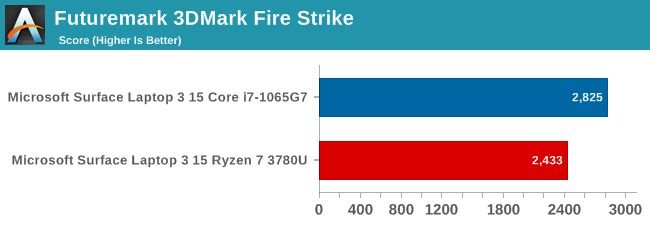
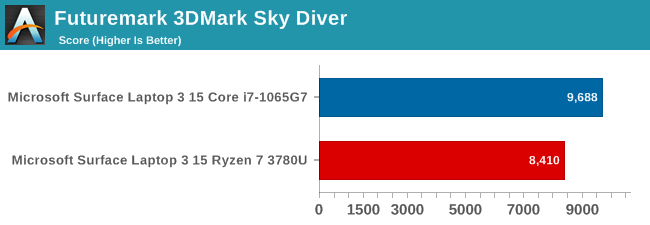
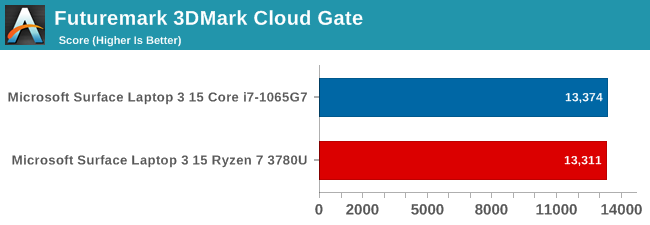
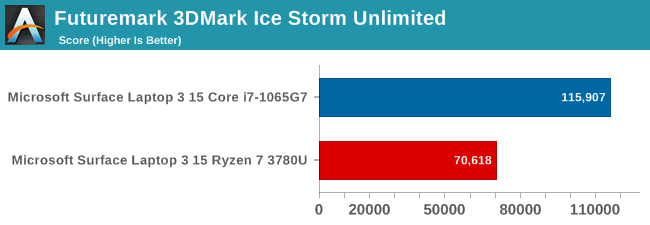
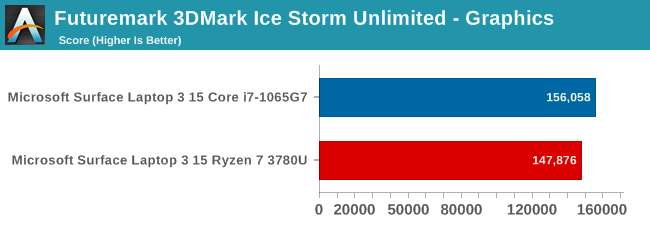
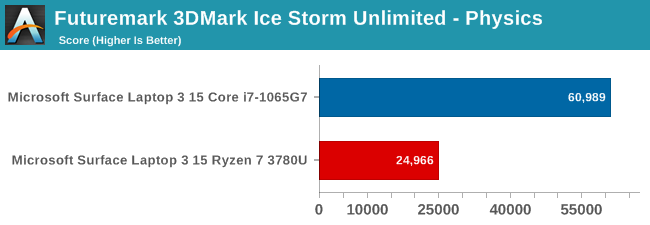
3DMark offers several tests of varying complexity, from Fire Strike as the most demanding, to Ice Storm Unlimited, which can be run on tablets. Here the Ice Lake platform pulls ahead, with better CPU performance helping quite a bit, although the Ice Lake’s Iris Plus graphics is also able to outperform Vega 11 as well.
GFXBench

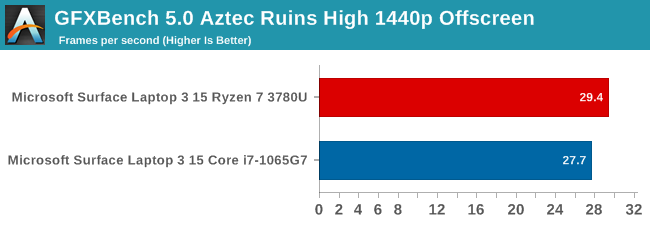
Kishonti’s latest GFXBench suite added DirectX 12 tests to the fold, making it far more relevant than the older OpenGL versions available on the desktop previously. AMD’s previous work in low-level drivers when they developed Mantle has provided the groundwork for DX12 as well, with Vega 11 offering slightly better results than Iris Plus in this test.
Tomb Raider

Running at our value settings, Tomb Raider was easily playable on both systems, with framerates approaching 100 FPS. The Ice Lake platform performed better on this test.
Rise of the Tomb Raider
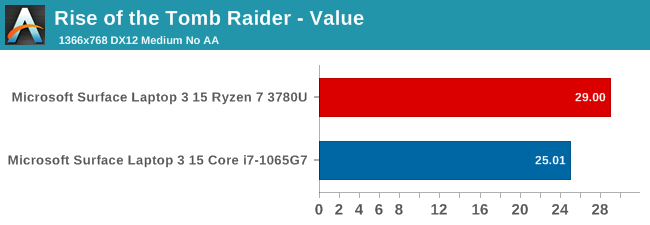
The second installment in the Tomb Raider series offers much more demanding visuals, and both systems struggle to play it at our value settings. The DirectX 12 title performs slightly better on Vega, and with some additional settings tweaks, the game would be playable, which is not something you could have said on an integrated GPU previous to Ryzen and Ice Lake.
Strange Brigade
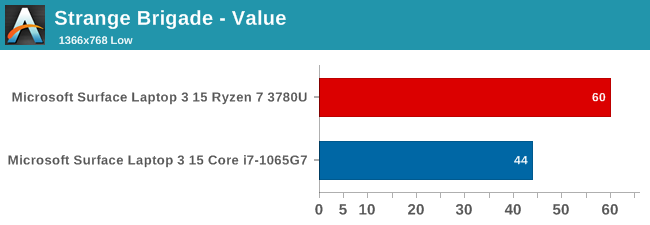
A new title we’re bringing to our laptop suite is Strange Brigade, which scales down nicely on integrated graphics. This game also supports DirectX 12, and as tends to be the pattern, performs very well on Vega 11.
F1 2017
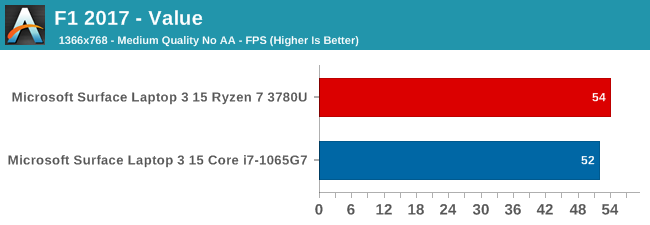
Back with a DirectX 11 title, we see that Intel has again closed the gap, and this game tends to be somewhat CPU bottlenecked as well, so the Sunny Cove cores likely help out here too, but once again Vega 11 wins, if only by a nose.
F1 2019
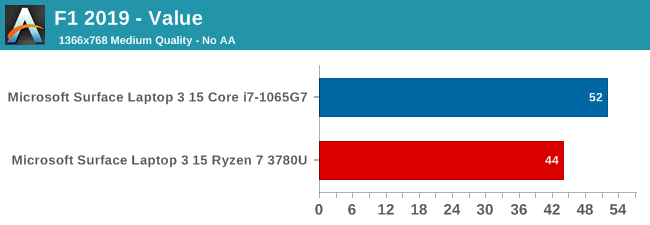
Codemasters updated the underlying EGO engine to support DirectX 12, which was utilized on this test. Despite that, the Vega 11 GPU is a bit slower than the Iris Plus in this test.
Far Cry 5
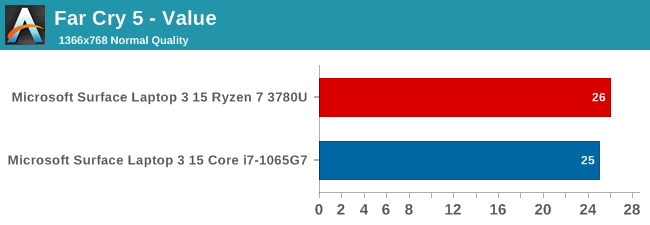
Both systems are within striking distance of being playable, which is somewhat remarkable since the Far Cry series is one of the most popular AAA first-person shooters. The Vega 11 GPU was slightly ahead, which is somewhat surprising as this game tends to be CPU bound, but clearly at this low of a GPU limit that hasn’t come into play yet.










174 Comments
View All Comments
yannigr2 - Saturday, December 14, 2019 - link
Nice. Let's run the single threaded SPEC2017 test to show how good Intel is against the new star, the Ryzen 9 3950.Let's run the multi threaded SPEC2017 test WITHOUT the desktop CPUs to avoid showing how bad Intel is against the Ryzen 9 3950.
yannigr2 - Saturday, December 14, 2019 - link
Thats way we can title both results as "Intel having an advantage"Where is the good old Anandtech?
Brett Howse - Saturday, December 14, 2019 - link
The comparison is 15W AMD to 15W Intel in the same laptop. Please refer to the title of the article.yannigr2 - Sunday, December 15, 2019 - link
Then why are there results from desktop processors ESPECIALLY on the SINGLE threaded performance, but no results on the multi threaded performance?Maybe to advertise the single threaded performance that Ice Lake offers, compared to Zen 2? Maybe because 16 Zen 2 cores obliterate Intel chips on multithreaded tests?
The fact that you avoid in the article to explain why you only post single threaded, but no multithreaded results from desktop processors explains much. Hides nothing.
One "Tom's Hardware" is enough. We don't need another.
Brett Howse - Sunday, December 15, 2019 - link
Because it's relevant on single-threaded but irrelevant on multi-threaded. If you're after desktop CPU reviews we have those as well. If we were going to run SPEC multi-thread on a desktop CPU we'd not be running it at Rate 8. Rate 8 was run on these two processors because they have 8 threads.Maxiking - Saturday, December 14, 2019 - link
Lol, amd trash brigading again.Haawser - Saturday, December 14, 2019 - link
I think 7nm Ryzen mobile will be a lot more competitive than Picasso. Which is 'ok' for a last generation 12nm effort, but unlikely to hold a candle to a 7nm Zen2 APU. So next year should be a really interesting one as far as notebooks are concerned.Cliff34 - Saturday, December 14, 2019 - link
Looking at the price, spec and performance, Intel is still the winner in the laptop areana. Why would anyone save 100 dollars for a laptop that is win home, slower and less battery life?eastcoast_pete - Saturday, December 14, 2019 - link
Two additional comments:1. The Ryzen version is overpriced; as is, it would still be an attractive option if the price would be $300 or so less. Right now, the value proposition is on the side of the Ice Lake i7 version.
2. Many comments here complain about how this comparison is unfair to AMD's APU. Why not complain about AMD not shipping a mobile APU based on Zen2 in 7 nm, preferably with Navi graphics on board, more L3 cache, and LPDDR4 support? Isn't that the likely reason for Ice Lake taking the cake here, and trouncing AMD?
As is, I view the current Ryzen mobile APUs as good choices for mid-level machines suitable for occasional e-sports gaming, not for running a premium ultraportable $ 2000+ laptop.
MBarton - Monday, December 30, 2019 - link
"2. Many comments here complain about how this comparison is unfair to AMD's APU. Why not complain about AMD not shipping a mobile APU based on Zen2 in 7 nm, preferably with Navi graphics on board, more L3 cache, and LPDDR4 support? Isn't that the likely reason for Ice Lake taking the cake here, and trouncing AMD?"Because all Zen 2 production is being channeled into HIGH profit server and HEDT CPU sales. While Intel fans get a moral victory in the Surface 3 review, their 10nm CPU parts are making Intel very little money using a process node they have burned billions trying to get working. AMD doesn't have the convenience of diverting valuable 7nm parts to low margin mobile sales. Congrats to Intel, they've won a much needed but very hollow victory.